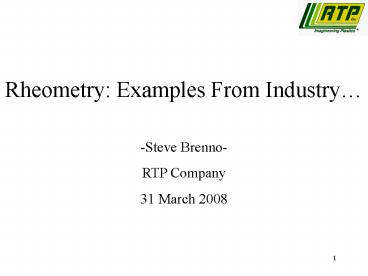Mold Design PowerPoint PPT Presentation
1 / 31
Title: Mold Design
1
Rheometry Examples From Industry -Steve
Brenno- RTP Company 31 March 2008
2
Lecture Outline
- General/Material Background
- Torque Rheometer (Process Development)
- Capillary Rheometer (Effect of Additive)
- Dynamic Rheometer (Material Design)
3
RTP?
- Independent custom compounder
- Established 1982 additional 20 year history
- 600 employees
- 7 Global manufacturing locations
- 4 in US
- 1 in France
- 1 in Singapore
- 1 in China
- Worldwide sales rep. and distribution system
4
RTP Products
5
TPE Industry Overview
- TPEs are a 3.5 billion pound global market (by
comparison, thermoset rubber for tires is a 5
billion pound market) - Thermoplastic market is 300 billion pounds
- North American consumption in 2003 was 1.8
billion pounds - TPE market has grown at 6-8 rate through 2003
and is projected to continue _at_ a 6 pace
6
ThermoPlastic Elastomer (TPE)?
Having the property of softening or fusing when
heated and of hardening again when cooled
Any of various elastic substances resembling
rubber
Int. Institute of Synthetic Rubber Producers
(IISRP) definition Polymers, polymer blends or
compounds which, above their melt temperatures,
exhibit thermoplastic character that enables them
to be shaped into fabricated articles and which,
within their design temperature range, possess
elastomeric behavior without cross-linking during
fabrication. This process is reversible and the
product can be reprocessed and remoulded.
7
How TPEs Work
TPEs are composed of hard and soft domainsthey
are dual phase materials at the nano- or
micro-scale in their solid state. - Hard phase
contributes plastic properties such as
tensile strength tear strength chemical
resistance high-temperature performance -
Soft phase contributes elastomeric properties
such as hardness compression tension
set flexibility low-temperature performance
8
But Why Are TPEs Rubbery?
Flexible
At usage temperature, the TPEs rubbery phase is
above its glass transition temperature region.
9
So How Are TPEs Melt Processible?
Heat
At processing temperature, the TPEs
plastic phase is above its glass transition
temperature region or melting point
for comparison, thermoset rubbers (TSRs) are
single phase materials with non-reversible
chemical (covalent) bond cross-links
10
A TPE Morphology (Nano-scale)
Tri-block copolymers (primarily) develop a
nanocomposite-like material
11
A TPE Morphology (Micro-scale)
Process dependent, two-phase morphology on the
micro-scale
12
Torque Rheometer
13
Mixing Chamber Rotors - I
14
Mixing Chamber Rotors - II
15
Instrument Background / Theory
- Concentric cylinder-style rheometer
- Non-uniform temperature and strain rate!
- Mean shear rate C1 Rpm
- Mean shear stress C2 Torque
- Efforts made to obtain viscosity data from
instrument output - (Example Journal of Rheology 43, 415 (1999))
- Unique ability to study rheology (transient
events) during polymer mixing/compounding
(reactions, stability/degradation, morphology
changes, etc.)
16
Industrial Uses
- Thermal stability studies (additives)
- Vulcanization/X-linking studies
- Quality control and failure analysis
- Melt blending studies
- Order-of-addition of fillers, extenders, etc.
- Additive incorporation (will it mix?)
- Screening experimentation
17
Case Study Process Development
- Technical problem Develop manufacturing process
for a flame retardant thermoplastic elastomer - Tool C.W. Brabender Prep-Mixer (roller rotors)
- Technique Conduct order-of-addition and
additive incorporation experiments using a torque
rheometer prior to scale-up to a continuous
mixing device (twin screw extruder)
18
FR TPE Formulation
19
Experimental Data
20
Capillary Rheometer
21
Instrument Background / Theory
- Pressure-driven flow through a tube
- Shear stress and shear rate at wall easily
derived - Instrument is simple mathematically and
mechanically - Ability to switch load cell, transducer(s), and
die to optimize performance - High shear rate in measurement region similar to
levels of shear found in industrial processing
equipment and tooling (molds/dies)
22
Industrial Uses
- Processibility studies/ranking
- Ease-of-flow
- Degradation/residence time
- Extrudate swell
- Development of process models (moldflow)
- Quality control
- Fiber science and engineering
- Polymer chain/crystallite orientation
23
Case Study Effect of Additive
- Technical problem Will the presence of a small
amount of a polymeric modifier improve the
processibility of an optically clear SBC compound
used in an injection-molded article - Tool Dynisco LCR 7001 Capillary Rheometer
- Technique Prepare two compounds and analyze at
expected processing temperature (being careful to
utilize good experimental techniquepredry
samples, cleaning between runs, etc.)
24
Experimental Data
25
Dynamic Rheometer
26
Instrument Background / Theory
- Ability to measure viscoelastic properties of
polymer melts (?) and solids (E, G) using a
small oscillatory stress or strain - Superposition (time/frequency vs. temperature and
Boltzmann) are powerful concepts to extend
usefulness of rheometer - Material must not change under conditions of
tests! - Multiple instrument deformation modes (tension,
compression, torsional shear) relate directly to
loadings applied in numerous dynamic applications
(shock mounts, aircraft structures, tires)
27
Industrial Uses
- Polymer blend development (miscibility)
- Thermoset curing studies
- Polymer science and physics
- Molecular weight, MWD, branching, filler
interaction, plasticization - Mechanical design
- Creep and stress relaxation
- Dynamic response
28
Case Study Material Design
- Technical problem Develop an injection-moldable
TPE compound to replace a thermoset rubber
compound - Tool TA Inst. ARES dynamic rheometer (shear
mode) - Technique Perform temperature sweep at two
frequencies to obtain G vs. temperature boundary
curves. Compare to existing thermoset rubber
compound tested under similar conditions.
29
(No Transcript)
30
Experimental Data 1Hz
31
Lecture Outline
- General/Material Background
- Torque Rheometer (Process Development)
- Capillary Rheometer (Effect of Additive)
- Dynamic Rheometer (Material Design)

